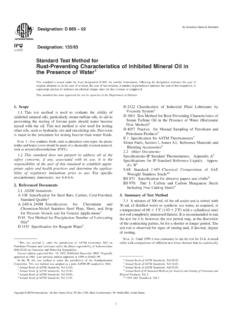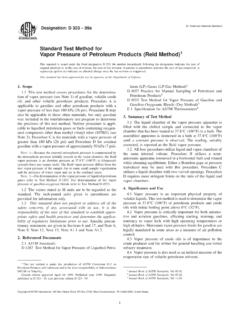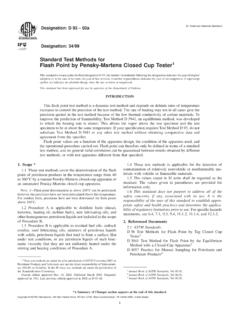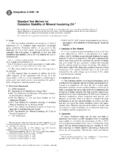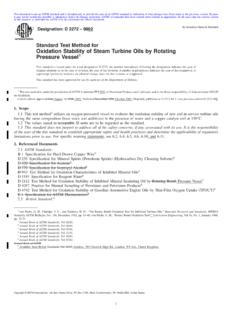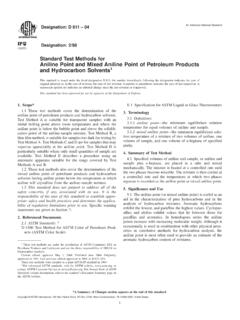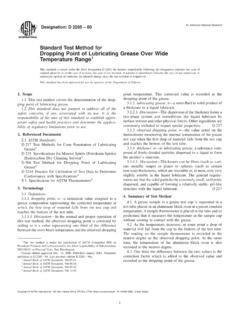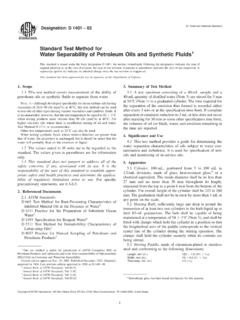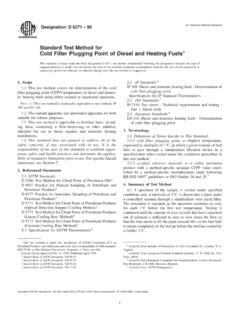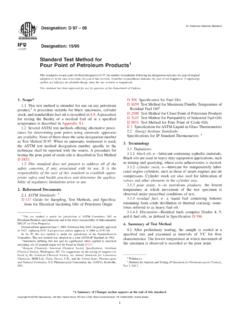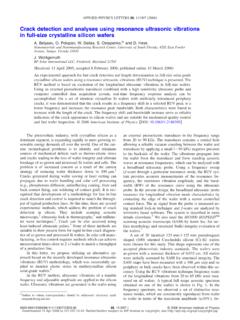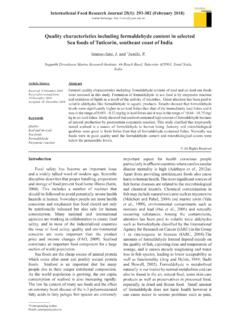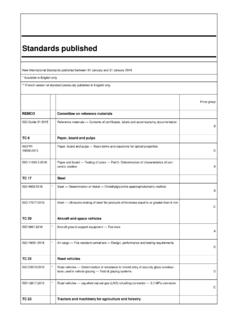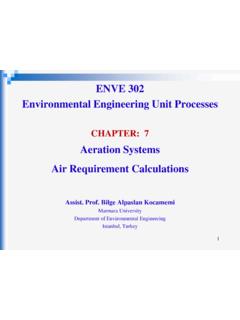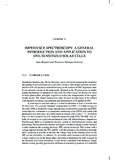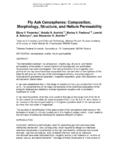Transcription of Standard Test Method for Foaming Characteristics …
1 Designation: D 892 03 Designation: 146/2000An American National StandardBritish Standard 5092 Standard Test Method forFoaming Characteristics of Lubricating Oils1 This Standard is issued under the fixed designation D 892; the number immediately following the designation indicates the year oforiginal adoption or, in the case of revision, the year of last revision. A number in parentheses indicates the year of last reapproval. Asuperscript epsilon (e) indicates an editorial change since the last revision or Standard has been approved for use by agencies of the Department of Scope* This test Method covers the determination of the foam-ing Characteristics of lubricating oils at 24 C and of empirically rating the Foaming tendency and thestability of the foam are The values stated in acceptable SI units are to beregarded as the Standard does not purport to address all of thesafety concerns, if any, associated with its use.
2 It is theresponsibility of the user of this Standard to establish appro-priate safety and health practices and determine the applica-bility of regulatory limitations prior to specificwarning statements, see Sections7,8, Referenced Standards:D 445 Test Method for Kinematic Viscosity of Transparentand Opaque Liquids and the Calculation of DynamicViscosity2D 4175 Terminology Relating to Petroleum, PetroleumProducts, and Lubricants3E 1 Specification for ASTM Thermometers4E 128 Test Method for Maximum Pore Diameter and Per-meability of Rigid, Porous Filters for Laboratory Use53. ,n for gas, a device for dispersing gas into In this test Method the diffuser may bemade of either metallic or non-metallic air (or gas),n in liquids, a two-phasemixture of air (or gas) dispersed in a liquid in which thevolume of the liquid is the major The air (or gas) is in the form ofdiscrete bubbles of about 10 to 1000 m in diameter.
3 Thebubbles are not uniformly dispersed. In time they tend to riseto the surface to coalesce to form larger bubbles which break orform foam. Subsurface coalescence can also occur, in whichcase, the bubbles rise more ,n in liquids, a collection of bubbles formed inthe liquid or on (at) its surface in which the air (or gas) is themajor component on a volumetric ,n any material interposed between twosurfaces that reduces the friction or wear between 4175 In this test Method , the lubricant is anoil which can or can not contain additives such as pore diameter,n in gas diffusion, thediameter a capillary of circular cross section which is equiva-lent (with respect to surface tension effects)
4 To the largest poreof the diffuser under The pore dimension is expressed inmicrometres in this test ,n in gas diffusion, the flow of gas,through the gas In this test Method , the permeability ismeasured at a pressure of kPa (250 mm of water) inmillilitres per of Terms Specific to This bubble,n the first bubble to pass throughand escape from the diffuser followed by a continuous succes-sion of bubbles when testing for the maximum pore diameter inAnnex When a diffuser is immersed in aliquid, air can be trapped in the pores. It can escape eventuallyor as soon as a pressure is applied to the diffuser. When testing1 This test Method is under the jurisdiction of ASTM Committee D02 onPetroleum Products and Lubricants and is the direct responsibility of on Analysis of edition approved May 10, 2003.
5 Published May 2003. Originallyapproved in 1946. Last previous edition approved in 2002 as D 892 the IP, this test Method is under the jurisdiction of the StandardizationCommittee. This test Method has been approved by the sponsoring committees andaccepted by the cooperating societies in accordance with established Book of ASTM Standards, Vol Book of ASTM Standards, Vol Book of ASTM Standards, Vol Book of ASTM Standards, Vol *A Summary of Changes section appears at the end of this ASTM International, 100 Barr Harbor Drive, PO Box C700, West Conshohocken, PA 19428-2959, United maximum pore diameter (Annex A1) the escape of suchbubble shall be stability,n in foam testing, the amount of foamremaining at the specified time following the disconnecting ofthe air In this test Method ,foam stability isdetermined from measurements made 10 min610 s afterdisconnecting the air tendency,n in foam testing, the amount offoam determined from measurements made immediately afterthe cessation of air Summary of Test The sample, maintained at a temperature of 24 C (75 F)is blown with air at a constant rate for 5 min, then allowed tosettle for 10 min.
6 The volume of foam is measured at the endof both periods. The test is repeated on a second sample C (200 F), and then, after collapsing the foam, at 24 C(75 F).5. Significance and The tendency of oils to foam can be a serious problemin systems such as high-speed gearing, high-volume pumping,and splash lubrication. Inadequate lubrication, cavitation, andoverflow loss of lubricant can lead to mechanical failure. Thistest Method is used in the evaluation of oils for such Test Apparatus, an example of a suitableset-up is shown inFig. 1, consisting of a 1000-mL graduatedcylinder or cylinders held in position when placed in the baths,such as fitted with a heavy ring or clamp assembly to overcomethe buoyancy, and an air-inlet tube, to the bottom of which isfastened a gas diffuser.
7 The gas diffuser can be either (1-in.) diameter spherical gas diffuser stone6made offused crystalline alumina grain, or a cylindrical metal diffuser7made of sintered five micron porous stainless steel (Note 1).The cylinder shall have a diameter such that the distance fromthe inside bottom to the 1000-mL graduation mark is 360625mm. It shall be circular at the top (Note 2) and shall be fittedwith a stopper, such as those made of rubber, having one holeat the center for the air-inlet tube and a second hole off-centerfor an air-outlet tube. The air-inlet tube shall be adjusted sothat, when the stopper is fitted tightly into the cylinder, the gasdiffuser (Note 3) just touches the bottom of the cylinder and isapproximately at the center of the circular cross section.
8 Gasdiffusers shall meet the following specification when tested inaccordance with the Method given inAnnex A1:Maximum pore diameter, mNot greater than 80 Permeability at pressure of kPa (250 mm) water,mL of air/min3000 to 6000 NOTE1 Gas diffuser permeability and porosity can change during use;therefore, it is recommended that diffusers be tested when new andperiodically thereafter preferably after each Graduated cylinders with circular tops can be prepared fromcylinders with pouring spouts by cutting them off below the spouts. Thecut surface is to be smoothed before use by fire polishing or Gas diffusers may be attached to air-inlet tubes by anysuitable means. A convenient arrangement is shown inFig.
9 Sole source of supply of the diffuser stones known to the committee at thistime is Norton Co., Industrial Ceramics Div., Worcester, MA 01606, under thedesignation AX536, Alundum porous If you are aware of alternativesuppliers, please provide this information to ASTM International comments will receive careful consideration at a meeting of the responsibletechnical committee1, which you may sole source of supply of the metal diffusers known to the committee at thistime is Petrolab Corp., 874 Albany-Shaker Road, Latham, NY 12110 under thedesignation M13-0653. The names of suitable suppliers of diffuser stones and metaldiffusers in the United Kingdom may be obtained from the Institute of you are aware of alternative suppliers, please provide this information to ASTMI nternational Headquarters.
10 Your comments will receive careful consideration at ameeting of the responsible technical committee1, which you may 1 Foaming Test ApparatusD892 Baths, large enough to permit the immersion of thecylinder at least to the 900-mL mark and capable of beingmaintained at temperatures constant to C (1 F) at 24 C(75 F) and C (200 F), respectively. Both bath (Note 5)and bath liquid shall be clear enough to permit observation ofthe graduations on the Air baths may also be utilized for heating purposes. Limiteddata has shown that both liquid and air baths give equivalent , the precision estimates given in Section13are based on usingonly liquid Heat-resistant cylindrical glass jars approximately 300 mm(12 in.)
